Kansas state assessment scores decrease, with only 40 percent of students meeting proficiency
USD 232 district scores, though, have been consistently higher than state scores
Kansas student state assessment scores from 2017 decreased from 2016, with only 40 percent of students meeting proficiency levels. Scores for the USD 232 district, though, have consistently exceeded state averages.
November 16, 2017
Kansas standardized test scores for math and English language arts have decreased since 2016, with proficiency rates for students reaching below 40 percent. However, USD 232 has consistently remained above these state averages.
For the state of Kansas, 38 percent of students were proficient in English language arts and 34 percent were proficient in math for the spring 2017 test. USD 232 student scores indicated proficiency rates of 58 percent for English language arts and 53 percent for math.
The state introduced a new assessment in 2014, which altered the format of both the test and its scores. Test results are now grouped in four categories: level four performs above grade level and is college- and career-ready; level three performs at grade level and is college- and career-ready; level two performs at grade level but is not college- and career-ready; level one performs below grade level. Students with scores in the level four or level three categories are proficient, or college- and career-ready.
 In addition, although the 2016 and 2017 tests were similar in content, the 2017 test was administered through computers only, removing the written performance components.
In addition, although the 2016 and 2017 tests were similar in content, the 2017 test was administered through computers only, removing the written performance components.
According to USD 232 director of school improvement Michelle Hite, because of this change, this year’s test results cannot be compared to test results of previous years.
“Until the state assessment variables remain the same for consistent years, validity to gauge year-to-year results will be difficult to assess,” Hite said.
English teacher Anna Nelson said that because of the differences in tests, it is difficult for teachers to adequately prepare students.
“I get that they want to try to measure different things, but we feel a little frustrated,” Nelson said. “It’s hard to predict what the test is going to look like.”
In addition to discrepancies in the test format, senior Landon Butler said that this year’s score results are misleading because of issues with the software of the test.
“I think the issue lies in the software of the state assessments rather than the educational abilities of the kids in Kansas,” Butler said. “This is reinforced by our ACT scores and AP scores — these have remained consistent over the past few years, so I don’t think these results are something to worry about.”
Regardless of state scores, though, the district has always performed above average. Assistant principal Jennifer Smith credits this performance to the hard work of both teachers and students.
“[Teachers] take that time to get to know their students and to help them be successful,” Smith said. ““We have great students. They care about their education; I think most students see the value in [education] and work hard to achieve their best.”
Smith said that the district does not have a specific goal for standardized testing performance since it instead wants to focus on the individualization of students.
“I don’t always like to say that our goal is to get X percent there, because whenever you do that, you’re leaving out some students,” Smith said. “It’s really looking at where each individual student is, and how we can, as a staff and as a family, work together to help each student improve.”










